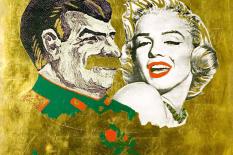Sots Art retraces the development of a movement which, from the early 1970s and in the wake of Socialist Realism, would stand out as the first original art movement in Russia since the 1920s avant-garde. The term was coined in 1972 by two Moscow artists, Vitaly Komar and Alexander Melamid, as a take on Pop Art, "Sots" being a contraction of Socialism and Art.
Shows & Exhibitions

Philadelphia Museum of Art hosts the first U.S. exhibition of tapestries by South African artist William Kentridge (born 1955), whose work, encompassing drawing, video, sculpture and theatre, has made him one of the most eloquent artistic voices to emerge in South Africa. In conjunction with the exhibition, the Museum presents a series of discussions and readings as part of Art and Social Transformation

The University of Essex Gallery presents a group exhibition of internationally acclaimed contemporary artists Richard Wentworth, Duane Michals, Jorge Macchi, Ivan Navarro, Chema Madoz, and the emerging artists Frode Fjerdingstad and Marcus Palmqvist . The show has been organised by a group of 5 up-and-coming curators on MA Gallery Studies and Critical Curating for the 21st Century course at the University of Essex.

Mark Maxwell’s installation, Positive Negative + -, draws on the experiments of Benjamin Franklin, inventor, man of Reason and one of the founding fathers of America. Housed within the east walk of the church of St. Bartholomew the Great, Postive Negative takes elements and influences from the space it occupies, and is composed of two sculptures and two video pieces.

The Projection Project: Budapest episode investigates how art offers alternatives to the projections we are faced with every day: a dominance of phantasmagorical image-making, of images carried by state of the art technology and sustained by politics, commerce, and the entertainment industry, that rises above everyday reality.

The 16th International Electronic Art Festival_SESC Videobrasil will be held for the first time ever at the SESC Avenida Paulista provisional unit, taking over all five floors of the building with video and film screenings, exhibitions, installations, lectures, debates, meetings, and workshops. Guests will include some of the greatest pioneers in the fields of experimental filmmaking, expanded cinema, and video art.

In a monumental effort to raise awareness about worldwide use of food resources, an international artists' group will build an edible version of the Brighton Pavilion, using 10,000 kilos of vacuum-packed rice destined to feed children in need in Uganda. The Rice Pavilion aims to stress the importance of avoiding food waste. Crucially, its 'building blocks' will provide one basic meal for approximately 100,000 children, or will feed up to 3,300 children for a whole month.

Contour 2007 - third biennial for video art has been given the subtitle Decoder. The exhibition presents a number of video and film works in a double-edged line of enquiry. It investigates the perceptual and rhetorical mechanisms that exist which affect and shape how people assimilate their comprehension of the world. Within this investigation it also analyses the contemporary tendencies within lens-based media art practices for looking at the particular issue above, whether self-reflexive or not.

The theme of the Gergiev Festival's twelfth edition is Liebesnacht. From 5 to 15 September, 2007, the eleven-day festival presents symphonic music, chamber music, films, children's performances, a masterclass and a late-night programme. At the heart of the festival are three performances of Wagner's opera Tristan und Isolde, in a production featuring video art by Bill Viola. 'It could well be a very long time before something this great comes our way again,' was the enthusiastic response in the Los Angeles Times.

Grace Lau’s photographic project began during research in picture archives and collections for her book “The Chinese: Early Photographic Representations” in which she explored photographic portraits made by Westerners during the turbulent years in China between the Opium wars and the Boxer Rebellion. 21st Century Types combines and addresses the politics of cultural representation, the genre of contemporary portraiture and the question of visual “archives”.





